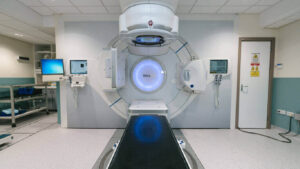Lymphedema is a condition that can significantly impact a person’s life. It involves the accumulation of lymph fluid, leading to swelling, primarily in the arms or legs. Early diagnosis and continuous monitoring are essential in managing this condition effectively. One of the most valuable tools in diagnosing and monitoring lymphedema is ultrasound. This non-invasive, cost-effective technique gives clinicians essential insights into the condition’s progression, helping them make informed treatment decisions.
Definition of Lymphedema
Lymphedema is a chronic condition in which there is an abnormal buildup of lymph fluid in the body, causing swelling. This typically occurs in the arms or legs but can affect other parts of the body. It often arises when the lymphatic system is unable to drain lymph properly, either due to damage to the lymphatic vessels or nodes.
Importance of Early Diagnosis and Monitoring
The early detection of lymphedema is crucial because it can help prevent severe complications, including infections and skin changes. Monitoring lymphedema over time is also vital to track the condition’s progression, evaluate the effectiveness of treatments, and prevent further complications. Ultrasound has become one of the primary diagnostic tools for this purpose due to its ability to provide detailed images without invasive procedures.
Overview of Ultrasound as a Diagnostic Tool
Ultrasound is a diagnostic imaging tool that uses sound waves to create images of the inside of the body. In the context of lymphedema, it assesses the lymphatic system’s functionality, measures swelling, and monitors any changes over time. This method is preferred due to its non-invasive nature, cost-effectiveness, and ability to produce real-time results.
Understanding Lymphedema
Causes and Risk Factors
Lymphedema can arise from various causes, both primary and secondary:
- Primary lymphedema is usually inherited and develops when malformed or absent lymphatic vessels are present.
- Secondary lymphedema is more common and often results from damage to the lymphatic system due to surgery (e.g., cancer treatments), radiation therapy, infections, or injuries.
Certain factors can increase the risk of developing lymphedema, including obesity, advanced age, and a history of lymph node removal or radiation therapy.
Symptoms and Stages of Lymphedema
Lymphedema progresses in stages:
- Stage 0 (Latency stage): The lymphatic system is damaged, but no swelling is visible.
- Stage 1 (Reversible stage): Mild swelling can be reduced with elevation and compression.
- Stage 2 (Spontaneously irreversible stage): Swelling becomes more severe and cannot be reversed without treatment.
- Stage 3 (Elephantiasis stage): The swelling is permanent and may cause severe fibrosis and skin changes.
Symptoms include swelling, a feeling of heaviness, restricted movement, and, in some cases, frequent infections.
Impact on Quality of Life
Lymphedema can profoundly impact a person’s quality of life. The swelling may lead to discomfort, pain, and mobility issues, and in advanced stages, it can cause significant skin changes. Due to the visible nature of the condition and its impact on daily activities, individuals with lymphedema often experience psychological distress.
The Role of Ultrasound in Diagnosis
Types of Ultrasound Used in Lymphedema Assessment
There are two primary types of ultrasound used in the assessment of lymphedema:
1. B-mode Ultrasound
B-mode ultrasound is the most common technique for visualizing the internal structure of tissues. It creates cross-sectional images of the soft tissues, allowing clinicians to see areas of swelling and fluid accumulation. This method helps detect early signs of lymphedema and track its progression over time.
2. Doppler Ultrasound
Doppler ultrasound measures the flow of blood or lymph within the vessels. It is particularly useful in assessing whether the lymphatic fluid is being adequately drained. Doppler ultrasound can identify areas of congestion or abnormal flow, helping doctors understand how the lymphatic system functions and how lymphedema may affect it.
Advantages of Ultrasound Over Other Imaging Techniques
Ultrasound offers several advantages over other imaging techniques, such as CT or MRI scans:
- Non-invasive: Unlike CT and MRI, ultrasound does not require injections or radiation exposure.
- Real-time imaging: Ultrasound provides immediate results, enabling faster decision-making for treatment.
- Cost-effective: Ultrasound is more affordable compared to other imaging methods, making it a practical option for regular monitoring.
- Portable: Ultrasound machines can be used in various settings, from hospitals to outpatient clinics, and even at patients’ homes for convenience.
How Ultrasound Helps in Identifying Lymphedema
Ultrasound plays a pivotal role in the early detection of lymphedema. It allows healthcare professionals to measure the thickness of the soft tissues, observe the accumulation of lymph fluid, and monitor any changes over time. By providing clear images of the affected areas, ultrasound helps differentiate between different stages of lymphedema and provides a foundation for effective treatment planning.
Monitoring Lymphedema with Ultrasound
Regular Assessments and Their Significance
Regular ultrasound assessments are essential in managing lymphedema. These assessments help clinicians monitor the swelling’s progression and the effectiveness of treatments. By conducting routine checks, doctors can identify changes in the lymphatic system early, allowing for timely interventions.
Ultrasound in Tracking Treatment Effectiveness
Ultrasound is also invaluable in assessing the effectiveness of treatment interventions. Treatments like compression therapy, manual lymphatic drainage, or surgical procedures can be monitored using ultrasound to evaluate how well they reduce swelling and improve lymphatic function. This real-time feedback ensures that the most effective treatment plans are followed.
Case Studies and Examples of Ultrasound Monitoring
Case studies demonstrate how ultrasound has helped in monitoring lymphedema:
- Case 1: An early-stage lymphedema patient was monitored using ultrasound. The scans revealed mild swelling, and after consistent compression therapy, follow-up ultrasounds showed a significant reduction in fluid accumulation.
- Case 2: A patient with advanced lymphedema underwent a Doppler ultrasound, highlighting poor lymphatic drainage. This led to a change in the treatment plan, incorporating more intensive therapy to improve lymph flow.
These examples highlight the role of ultrasound not only in diagnosing but also in managing lymphedema effectively.
Conclusion
Ultrasound has emerged as an essential tool in diagnosing and monitoring lymphedema. Its ability to provide detailed, real-time images without invasive procedures offers significant advantages over other diagnostic techniques. Regular ultrasound assessments can help track the condition’s progression, assess treatment effectiveness, and improve patient outcomes. For those living with lymphedema, early diagnosis and consistent monitoring are key to managing the condition and maintaining a better quality of life.
FAQs
1. Can ultrasound detect lymphedema in its earliest stages?
Yes, ultrasound can detect subtle changes in the lymphatic system, allowing for the early identification of lymphedema, even before visible swelling occurs.
2. How often should an ultrasound be used to monitor lymphedema?
The frequency of ultrasound assessments depends on the severity of the condition, but regular monitoring every 3–6 months is recommended for most patients.
3. Is ultrasound a painful procedure?
No, ultrasound is a non-invasive and painless procedure. It uses sound waves to create images, making it a comfortable diagnostic tool.
4. Can ultrasound replace other tests for lymphedema?
While ultrasound is highly effective, it is often used alongside other tests such as physical exams or MRI scans to provide a comprehensive assessment.
5. How long does an ultrasound session for lymphedema take?
An ultrasound session for lymphedema typically takes 15 to 30 minutes, depending on the area being examined and the complexity of the case.





